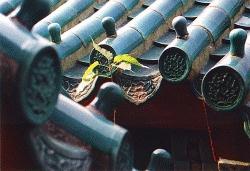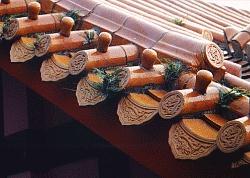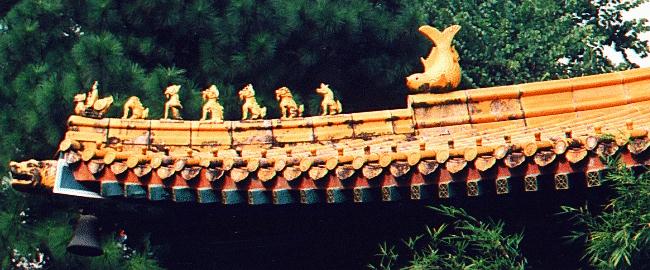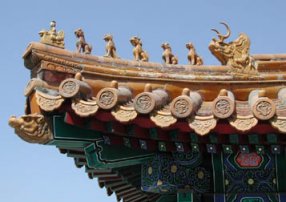- Call Us :+86 13663796880
- Email :nicole@sfrooftile.com
- Working hours :24 hours a day
- Language :Chinese
Nicole Zhang
+86 13663796880
+86-379-63262958
nicole@sfrooftile.com
Roofs are very important to Chinese architecture: Not only do they protect residences from the elements, but they also have a deeper meaning. For example, temple roofs are curved because Buddhists believed that this helped ward off evil spirits, which were believed to assume the form of straight lines. Temple roofs were also made of glazed ceramic tiles and have an overhanging cave distinguished by a graceful upward slope. The roof arch comes from the intricately fitted rafters, which were jointed together.
Wealthy homes and palaces had particularly elaborate roofs. One perfect example is the Forbidden City, and the 13 Ming tombs outside of Beijing have roof tiles of brilliant yellow, green and red hues. The ridges of each roof are topped with figures of mythical creatures, each curve no more than a sweep, and the most intricate designs almost always pointing southeast. However, there are some obstacles to having such decorations on the roof: The tremendous weight can eventually bring down the entire complex. This is why the Chinese have added an additional column to support the weight under the outer edges, reducing the bracket system to a mere decoration. The brackets are decorated by elaborate paintings with bright colors and eye-catching designs.

 The distinctive roof of Chinese architecture involves a great deal of symbolism. Symbolism is present in the colors of the eaves, roofing materials and roof top decorations. A roof usually has wave-like tiles that run horizontally, and vertical round ridges that run vertically. The vertical ridges are symbolic of bamboo, which represents youth and longevity. Since gold/yellow is an auspicious (good) color, imperial roofs are gold or yellow. Green roofs symbolize bamboo shafts, which, in turn, represent youth and longevity.
The distinctive roof of Chinese architecture involves a great deal of symbolism. Symbolism is present in the colors of the eaves, roofing materials and roof top decorations. A roof usually has wave-like tiles that run horizontally, and vertical round ridges that run vertically. The vertical ridges are symbolic of bamboo, which represents youth and longevity. Since gold/yellow is an auspicious (good) color, imperial roofs are gold or yellow. Green roofs symbolize bamboo shafts, which, in turn, represent youth and longevity.
 This eaved roof (left) can be found at the Wong Tai Sin Temple complex in Kowloon in Hong Kong. From left to right the roof decorations include a dragon with a bell underneath, a man on a chicken, various guardian beasts and a carp, which is believed to bring success. The more important a building, the more guardians it includes. The number of roof levels also signifies status. Roof guardians are installed to protect the building from evil spirits, fire, etc.
This eaved roof (left) can be found at the Wong Tai Sin Temple complex in Kowloon in Hong Kong. From left to right the roof decorations include a dragon with a bell underneath, a man on a chicken, various guardian beasts and a carp, which is believed to bring success. The more important a building, the more guardians it includes. The number of roof levels also signifies status. Roof guardians are installed to protect the building from evil spirits, fire, etc.
 This eaved roof (right) is from the Hall of Supreme Harmony in the Forbidden City in Beijing. As a very important building, it features more guardians than above. It includes a man on a chicken, various guardian beasts, xing she (winged demon leaning on a sword -- one of a kind at the Forbidden City) and a dragon, which symbolizes royalty and power. With 11 figures in total, the Hall of Supreme Harmony is the most important building in the Forbidden City. The double-layered roof makes the palace even more magnificent.Animal figures on roof ridges of palaces, temples and other old buildings are not only zoomorphic ornaments of the building, but they also represent the owner's status in the feudal hierarchy.
This eaved roof (right) is from the Hall of Supreme Harmony in the Forbidden City in Beijing. As a very important building, it features more guardians than above. It includes a man on a chicken, various guardian beasts, xing she (winged demon leaning on a sword -- one of a kind at the Forbidden City) and a dragon, which symbolizes royalty and power. With 11 figures in total, the Hall of Supreme Harmony is the most important building in the Forbidden City. The double-layered roof makes the palace even more magnificent.Animal figures on roof ridges of palaces, temples and other old buildings are not only zoomorphic ornaments of the building, but they also represent the owner's status in the feudal hierarchy.
 This photo, taken at the Forbidden City in Beijing, depicts six small animals, with a large one on the far right with antlers and another on the lower part of the main ridge. A god riding on a phoenix leads the flock, followed by a kylin, phoenix, lion and other figures. It is believed that the immortal god can perceive evil spirits from far away and lead the beasts to fend them off.
This photo, taken at the Forbidden City in Beijing, depicts six small animals, with a large one on the far right with antlers and another on the lower part of the main ridge. A god riding on a phoenix leads the flock, followed by a kylin, phoenix, lion and other figures. It is believed that the immortal god can perceive evil spirits from far away and lead the beasts to fend them off.